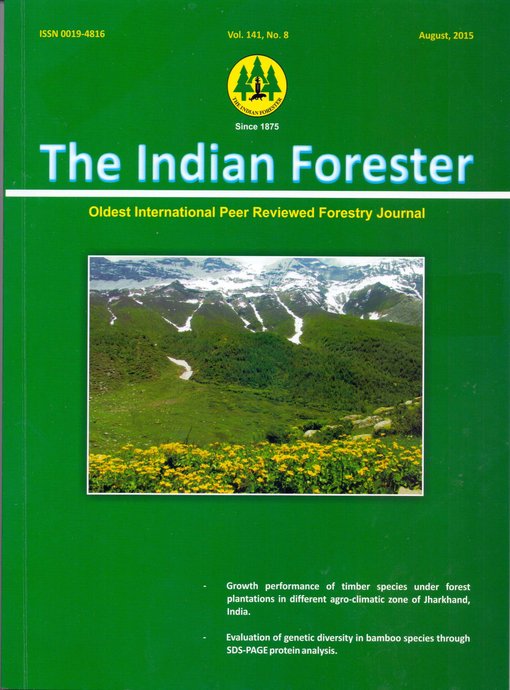Principal Component Analysis of Progenies of Selected Mother Trees of Drek (Melia Azedarach) for Quantitative Traits
DOI:
https://doi.org/10.36808/if/2015/v141i8/76995Keywords:
PCA, Quantitative Trait, Drek, Ortet, Component.Abstract
Mature seeds were collected from twenty seven mother trees (ortets) Melia azedarach selected at 27 sites, one ortet each at one site, from Himachal Pradesh and part of Punjab and their progenies were raised. Principal component analysis (PCA) was carried out taking 17 important parameters, proved useful in extracting the most important factors. Four principal components contributed 81.73% of total variance. First principal component contributed 44.51 % of total variation whereas the second component accounted for 21.69 % variation, the third explains 9.23 % of variation and the fourth component accounted for 6.24 % of the variation. In the first PCA high loadings for traits such as fresh shoot weight (0.916), dry shoot weight (0.911), dry root weight (0.859), root length (0.841), seedling height (0.773) and number of leaves (0.764) represented those which are important for selection and further improvement of the species. The study revealed that maximum weightage should be given to fresh shoot weight due to its maximum variable loading for the initial selection of progenies followed by dry shoot weight for the biomass improvement of the species.References
Chopra R.N., Nayar S.L. and Chopra I.C. (1956). Glossary of Indian medicinal plants. CSIR New Delhi Publication, pp. 163-165
Gupta A. (2006). Assessment of genetic variation in Salix alba L. using RAPD-PC technique. M. Sc Thesis. Dr. Y S Parmar UHF, Nauni, Solan (HP) India 100p.
Gupta R.K. (1993). Multipurpose trees for agroforestry. Oxford and IBH Publishing Company, New Delhi. 588p.
Isik F. and Toplu F. ( 2004). Variation in juvenile traits of natural black poplar (Populus nigra L.) clones from Turkey. New Forests, 27:175-182
Kaiser H.F. (1958). The varimax criterion for analytic rotation in factor analysis. Psychomethka, 23:187-200
Kirtikar K.R. and Basu B.D. ( 1954). Indian medicinal plants. Lalit Mohan Basu Publishers, Allahabad. 1675p.
Melville R. and Heybroek H.M..( 1971). The Elms of the Himalaya. Kew Bulletin 26(1). Royal Botanic Garden, Kew, London.
Namkoong G. (1984). Genetic structure of forest tree population. In: Proc. of the XV. International Congress of Genetics, Genetics New frontiers. (Chopra et al. eds.) Vol. IV. Oxford and IBH Publishing Co. 351p.
Singh B. (2006). Evaluation of new clones of Populus deltoides Bartr. developed from USA germplasm. Ph.D. Thesis FRI Dehradun, 172p.
Singh N.B. and Huse S.A. (2004). Improvement of tree willows in India: variation of wood characteristic. In: International Poplar Commission. 22nd session. Santiago, Chile, 29 Nov-2 Dec
Singh S.P. (1995). Favorite agroforestry trees. Agrotech Publishing Academy, Udaipur, pp. 212-215
Shukla K.S. and Bhatnagar R.C. (1988). Suitability of Indian timbers for compressed wood shuttle blocks. J Timb Dev Assoc India, 34(1): 53-58
Tunctaner K. (2002). Primary selection of willow clones for multi-purpose use in short rotation plantation. Silvae Genetica, 51(2-3): 105-112
Warrier P.K., Nambiar V.P.K. and Ramankutty C. (1997). Indian medicinal plants. Vol. IV, Orient Longman Ltd., Madras, pp. 10-14
Watt G. (1972). Dictionary of the economic products of India. Vol. II, Cosmo Publishers, Delhi, pp. 221-223.
Downloads
Downloads
Published
How to Cite
Issue
Section
License
Unless otherwise stated, copyright or similar rights in all materials presented on the site, including graphical images, are owned by Indian Forester.





